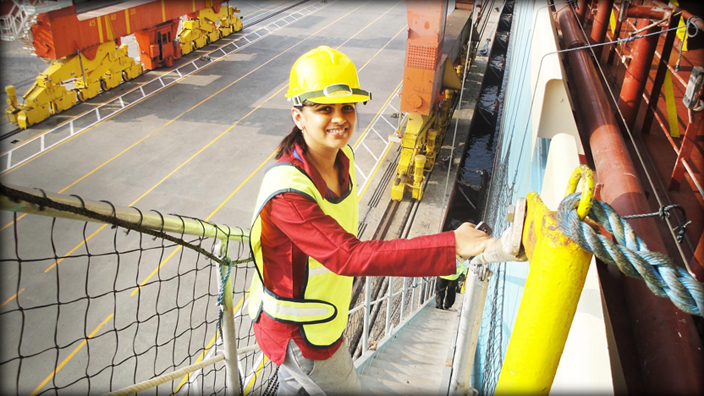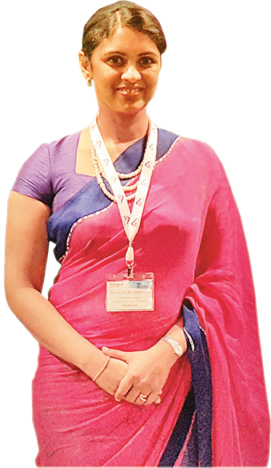|
Dhashma encourages more women to maritime sector:
Col. Port needs int'L marketing strategy
by Chandani Jayatilleke
If you think the Ports and Shipping industry is all about ships,
containers, warehouses, yards and men, you are probably misinformed.
Although ports and shipping has traditionally been a male-dominated
industry, the number of women entering the sector now is encouraging.
Yet improvement in women representation in the industry is vital as the
current share of women in the industry is a mere 2.9 percent.
 We met a young maritime professional Dhashma Karunaratne who works as
the Commercial and Marketing Manager of the South Asia Gateway Terminals
(SAGT) to find out about her exciting career, working environment at the
South Asia's top container terminal and her views on the future
challenges of the maritime industry of Sri Lanka. We met a young maritime professional Dhashma Karunaratne who works as
the Commercial and Marketing Manager of the South Asia Gateway Terminals
(SAGT) to find out about her exciting career, working environment at the
South Asia's top container terminal and her views on the future
challenges of the maritime industry of Sri Lanka.
A Chartered Global Management Accountant, Dhashma entered the
shipping industry as she was always intrigued by this industry. Today
she contributes to the company's growth; thereby contributing to the
growth of the national economy.
Excerpts of the interview
Question: How did you get where you are today?
Answer: At John Keells Holdings, I was responsible for the
Boston Consultant Groups' portfolio evaluation exercise and was indeed
intrigued by the port and shipping industry. The scale, the return, the
contribution to the national economy and the mystery of SAGT set me on a
journey of exploration.
Over the years I have held many roles in Management Accounting,
Corporate Finance and Business Strategy and Commercial and Compliance.
In my current role I am responsible for contributing to the commercial
and marketing strategy of SAGT. My role is multi-faceted; I drive
initiatives for business growth integrating contractual performance
monitoring and compliance on one side and on the other I am responsible
for building constructive networks with associated industry stakeholder
groups while promoting the SAGT, Port of Colombo brand.
Q: Since you joined this profession, what challenges have you
seen in the maritime industry?
A: The business landscape has changed immensely for SAGT, Port
of Colombo and for the entire global industry. On one hand the slowdown
of the global economy has impacted the shipping industry; on the other
hand the order book for large ships continues to grow, creating an
imbalance in the supply and demand equation. Many Shipping lines have
resorted to mergers and acquisitions, and entering into more
partnerships as slot operators. This has made contractual negotiations
challenging for terminal operators.
On a regional perspective, Colombo port is the transshipment hub for
India, with 70% of our transshipment volume to and from the Indian
subcontinent. The Colombo port has complimented the growth trajectory of
India; however India, as outlined in the 'Sagarmala' Maritime Policy,
aspires to become a gateway to the world. These aspirations are gaining
fruition with Jawaharlal Nehru Port Mumbai's second phase, Vizhinjam
Port, Kamaraj Port (Ennore) port developments in India. The global
terminal operators such as DP world are doubling their investments in
India. Last February, DP world announced their future plans, with a
capital infusion of US$ one billion. In a recent announcement, the
Indian government declared intentions of halving the previously
estimated 10-year timeframe to complete the Sagarmala port development
project. India is becoming more flexible towards foreign investors; to
form an Indian holding company. Even in my recent visits to the Ports in
India, I have witnessed the shift in the ways of doing business.
In the local industry, the addition of deep draught handling
facilities has further enhanced Port of Colombo's relevance to global
shipping. SAGT has seen a slight decline in volumes year on year.
However we have been resilient, by maintaining appropriate value
proposition to our customers and continuing to create shareholder value,
year over year. We have been focused in our strategy, strengthening our
unique selling point, best in class Productivity and commercial
flexibility in support of our customers.
The Sri Lanka Ports Authority has done very well to sustain Colombo's
strategic value. In my view the on boarding of the East Container
Terminal as the second deep draught facility will further advance our
position.
Q: What has your profession taught you?
A: Performance excellence is a commitment to be the best.
Performance outcomes are the result of careful strategic planning
involving in the various stakeholders. SAGT was recently ranked first in
South Asia and fourth in the world for productivity. This is a
remarkable achievement for Sri Lanka and a wonderful endorsement of the
hard work, passion and commitment of team SAGT. Importantly, this
highlights the Port of Colombo's capacity and capability to deliver
mutually gainful outcomes to the international trade stakeholders as the
mega hub of South Asia.
Q: How do you encourage other young people to choose
professions which are not common and traditional?
A: Be the change you want to see. Step out of your comfort
zone; challenge yourself and always strive to be ahead of the pack;
dream of striving to become better than yesterday as a professional and
as a human being. You will indeed carve out your niche.
Q: If you are to see five changes in the logistics sector in
Sri Lanka - what are they?
A: A National Maritime Policy that gives direction and
complements the strategies for all ports with airports and land
transportation
An international Marketing Strategy for Port of Colombo, spear-headed
by Sri Lanka Ports Authority
Improvement in women representation in the industry, analysts say
currently it is a mere 2.9% of the industry.
Gender diversity in the top management of corporate entities.
Universities of Sri Lanka should place greater emphasis and focus
towards churning out more logisticians to this industry, in line with
the country's aspirations of making Sri Lanka a logistics hub.
|

Dhashma Karunaratne, FCMA (UK), MILT, Masters in Business
(University of Colombo), AIPM-HR,
Certified Forex Dealer (CBSL), is a past pupil of Bishop’s
College and Visakha Vidyalaya |
Q: Can you tell us how do you suggest implementing such ideas?
A: The formation of a National Maritime Policy, via a
professional advisory group with expertise from local and international
arena is the key. There are many talented Sri Lankans, living here as
well as abroad who could contribute towards this goal. It's important
that we drive a "Give back to Sri Lanka" initiative and gather this
talent pool. There are competent professional/ industry bodies such as
Chartered Institute of Logistics and Transportation (CILT), Ceylon
Association of Ships Agents; these institutions have a wealth of
experience that can contribute positively to an over-arching National
Maritime Logistic Policy.
Gender diversity must be a key focus area for organizations, many
studies show that gender-diverse and engaged business units outperform
those that are less diverse. Organizations cannot afford to ignore 50%
of the potential workforce and expect to be competitive in the global
economy. Women in Logistics and Transportation (WILAT), is a support
group that was formed to encourage women representation in this sector
by CILT. WiLAT is present in 18 countries with 1800 members, Women's
International in Shipping and Trading Association (WISTA) is another
such group. Through these dynamic groups, this necessary Gender
diversity can be achieved. We all have heard the statement; the youth of
today are the leaders of tomorrow, however this transformational career
journey is a complex one. Therefore good mentoring programs are of
paramount importance to develop this demography. SAGT has over the years
partnered with local universities to develop young logistic graduates
through solid mentoring programs, WiLAT Ignite, YPF - Inspire, WISTA
career fair are some of the key initiatives that are propelling the
change in the industry.
Q: How do you manage to strike a work/life balance?
A: Manage! That's a challenge. But I believe that I must give
my very best in everything I choose to do. As an employee I take pride
in what I do, I like the challenge and I like to see the impact I make
in my work place and the industry.
In my personal life, I strive to be a good wife, a loving mother, a
caring daughter, and a kind sister. I am blessed with a good support
system. My husband is my strength he gives me the freedom I need to do
my utmost for my job, knowing well that he is my number one. My mother
is my inspiration and my daughter is my fountain of joy. A good
childhood is indeed a solid foundation. My parents invested
sacrificially towards our education, they never held back and did their
utmost for their daughters, even at a very young age our mother taught
us to work towards a goal, draw up a plan and stick to a timetable. She
made every effort to celebrate and reward our achievements and
milestones. I aspire to leave a legacy for my own daughter and the many
daughters I have adopted in my career journey. |

